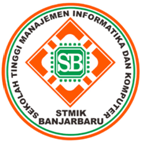Robot Virtual Menggunakan String Matching Pada Aplikasi E-Learning Universitas Muhammadiyah Sinjai
Abstract
The development of information technology is getting faster and communication is currently very complex besides that currently the learning model is now entering the era of digitalization and an increasingly popular technology is artificial intelligence, in the application of an artificial intelligence system Virtual Robot (Chatbot) is a solution to the problem of the unavailability of media interactive for students in the Sinjai Muhammadiyah University E-learning Application. This chatbot is intended as an interaction between humans and computers with natural language intermediaries. User input will be processed using the text mining method. The resulting response is a character match on the knowledge base using the string-matching method and produces the reply response that is considered the most suitable. String matching can only handle keywords that match the knowledge base. This string matching is matching a character on each keyword that has been specified. This chatbot will respond to input or questions more quickly and this chatbot will act as a virtual assistant for lecturers who can run 24 hours apart from that the chatbot is an interactive media for students to get information related to E-learning at Muhammadiyah Sinjai University.
Keywords: virtual robots; chatbots; string matching
Â
Abstrak
Perkembangan teknologi informasi makin cepat dan komunikasi saat ini sangat kompleks selain itu saat ini model pembelajaran pun kini sudah memasuki era digitalisasi dan teknologi yang kian populer adalah kecerdasan buatan, dalam penerapan sebuah sistem kecerdasan buatan Robot Virtual (Chatbot) merupakan solusi pada permasalahan belum tersedianya media interaktif bagi mahasiswa pada Aplikasi E-learning Universitas Muhammadiyah Sinjai. Chatbot ini bertujuan layaknya sebagai interaksi antara manusia dengan komputer dengan perantara bahasa alami. Inputan pengguna akan diproses menggunakan metode text mining. Respon yang dihasilkan merupakan pencocokan karakter pada knowledge base dengan menggunakan metode string matching dan menghasilkan respon balasan yang dianggap paling cocok. String matching hanya dapat menangani keyword yang tepat sesuai knowledge base. String matching ini yaitu pencocokan sebuah karakter pada setiap kata kunci yang telah di tentukan. Chatbot ini akan merespon inputan atau pertanyaan lebih cepat dan chatbot ini akan menjadi sebagai asisten virtual dosen yang bisa berjalan selama 24 jam selain itu chatbot sebagai media interaktif mahasiswa untuk mendapatkan informasi terkait E-learning Universitas Muhammadiyah Sinjai.
Kata kunci: robot virtual; chatbot; string matching
References
P. Megawanti, “Meretas Permasalahan Pendidikan di Indonesia,†J. Form., vol. 2, no. 3, pp. 227–234, 2015.
E. Bahartyan and N. Bahtiar, “Integrasi Chatbot Berbasis AIML Pada Website E-Commerce Sebagai Virtual Assistant dalam Pencarian dan Pemesanan Produk (Studi Kasus Toko Buku Online Edu41indo.com),†J. Masy. Inform., vol. 5, no. 10, pp. 34–43, 2015.
D. Jean, C. Sihombing, and A. Wirapraja, “Tren Penerapan Artificial Inteligence Pada Bidang Akuntasi, Energi Terbarukan dan Proses Industri Manufaktur (Studi Literatur),†J. Eksek., vol. 15, no. 2, pp. 302–315, 2018.
M.-H. Su, Chung-Hsien Wu, K.-Y. Huang, Q.-B. Hong, and H.-M. Wang, “A chatbot using LSTM-based multi-layer embedding for elderly care,†Int. Conf. orange Technol. (ICOT), IEEE, pp. 70–74, 2017.
A. Nugroho, D. P. Adi, and A. B. Gumelar, “Chatbot Untuk Customer Service Berbasis Teks dan Suara pada Sistem Manajemen Pemesanan ( OMS ) Menggunakan Platform Android,†Repositor, vol. 2, no. 6, pp. 683–690, 2020.
Tjut Awaliyah Zuraiyah, D. K. Utami, and D. Herlambang, “Implementasi Chatbot Pada Pendaftaran Mahasiswa Baru Menggunakan Recurrent Neural Network,†J. Ilm. Teknol. Dan Rekayasa, vol. 24, no. 2, pp. 91–101, 2020.
S. D. Ratri, Bain, and S. Amin, “Pengaruh Penggunaan Media Pembelajaran Sejarah Indonesia E- Learning Berbasis Quipper School Terhadap Minat dan Hasil Belajar Siswa Kelas X SMK N 04 Kendal Tahun Pelajaran 2016/2017,†Indones. J. Hist. Educ., vol. 5, no. 2, pp. 60–67, 2017.
V. A. Inamdar and R. D. Shivanand, “Development of College Enquiry Chatbot Using Snatchbot,†Int. Res. J. Eng. Technol., vol. 6, no. 7, pp. 1615–1618, 2019.
D. Suryani and E. L. Amalia, “Aplikasi Chatbot Objek Wisata Jawa Timur Berbasis AIML,†Smartics J., vol. 3, no. 2, pp. 47–54, 2017.
A. T. J. H, “Preprocessing Text untuk Meminimalisir Kata yang Tidak Berarti dalam Proses Text Mining,†J. Inform. UPGRIS, vol. 1, pp. 1–9, 2015.
K. Fitriani, Isbandi, and A. Amaliyah, “Perancangan Sistem Manajemen Dokumen dengan Menggunakan Metode Text Mining di Kantor Kelurahan Sekejati,†Telematika, vol. 3, no. 1, pp. 45–59, 2021.
H. Ma’rifah, A. P. Wibawa, and M. I. Akbar, “Klasifikasi artikel ilmiah dengan berbagai skenario preprocessing,†Sains, Apl. Komputasi dan Teknol. Inf., vol. 2, no. 2, pp. 70–78, 2020.
Y. Rochmawati and R. Kusumaningrum, “Studi Perbandingan Algoritme Pencarian String dalam Metode Approximate String Matching untuk Identifikasi Kesalahan Pengetikan Teks,†J. Buana Inform., vol. 7, no. 2, pp. 125–134, 2016.
D. Khurana, A. Koli, and K. Khatter, “Natural language processing : state of the art , current trends and challenges,†Multimed. Tools Appl., vol. 82, pp. 3713–3744, 2023.
T. A. Zuraiyah et al., “Implementasi Chatbot Pada Pendaftaran Mahasiswa Baru Menggunakan Recurrent Neural Network,†J. Ilm. Teknol. dan Rekayasa, vol. 24, no. 2, pp. 91–101, 2019.
How To Cite This :
Refbacks
- There are currently no refbacks.










